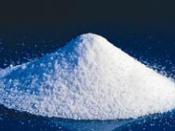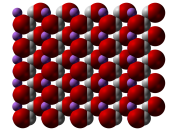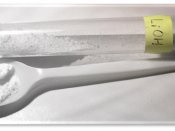Determination of the relative atomic mass of lithium
Introduction:
For this investigation I will determine the Relative atomic mass (Ar) by using two different methods. In the first method I will dissolve a piece of lithium of a known mass in water, I will then collect the hydrogen gas produced, which can be used to calculate the relative atomic mass of Lithium. In the second method I will titrate the resulting solution of lithium hydroxide with a known concentration of hydrochloric acid, this can also be used to calculate the relative atomic mass of lithium.
Readings:
*100 cm3 of water
*37.47 g of lithium plus the watch glass
*37.41 g of Watch glass
*122 cm3 of hydrogen gas collected
Calculations from method 1
Moles of hydrogen produced:
Assuming that 1 mole of gas occupies 24000 cm3 at pressure and room temperature!
I will now calculate the number of moles of the hydrogen gas produced.
I will do that by dividing the volume of gas produced by 24000cm3 :
Moles (n) = Volume (cm")
24000 cm"
So:
n = 122 cm" = 0.005083 mol of H2
24000 cm"
Equation:
2 Li(s) + 2 H2O (L)2LiOH(Ag) + H2 (g)
By looking at the Stoichiometry ratio in the reaction I can see that the ratio of Li: H2 is 2:1, therefore the number of moles of Li will be twice as the number of moles of H2 in the reaction.
So:
0.005083 x 2= 0.010166 mol of Li
Mass of Lithium =
Mass of the Lithium plus the watch glass - the mass of the watch glass
So:
37.47g - 37.41g = 0.06g
÷0.06g of lithium was used
Relative atomic mass of lithium:
I will now calculate the relative atomic mass of the piece of lithium that I used by rearranging...



Help
This stuff is foreign to me, but I can say that the language you use is very simple and easy to understand. The calculations part is where I lose it. Sorry, probably not much help to you.
2 out of 2 people found this comment useful.